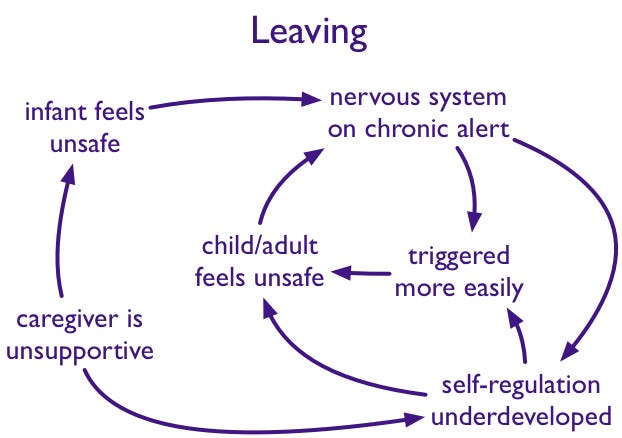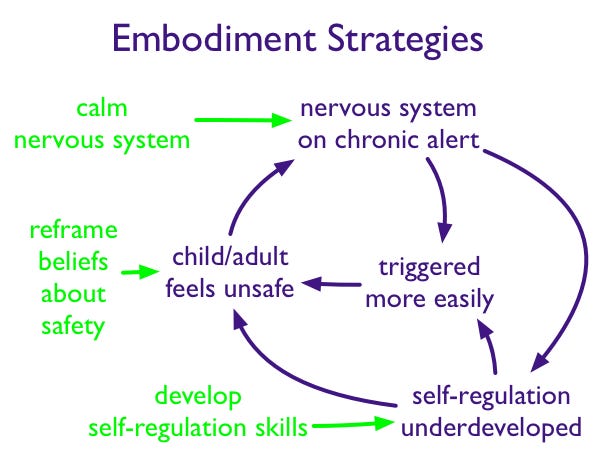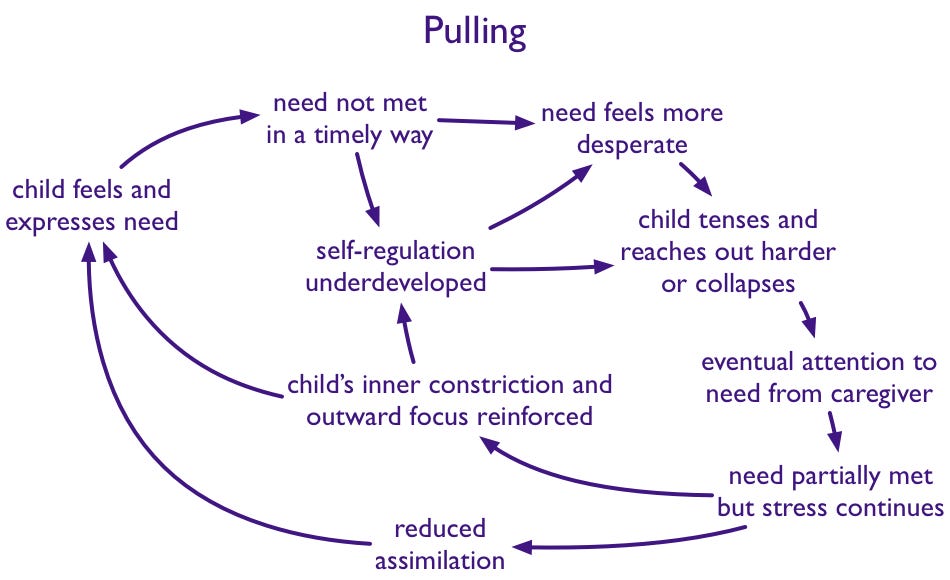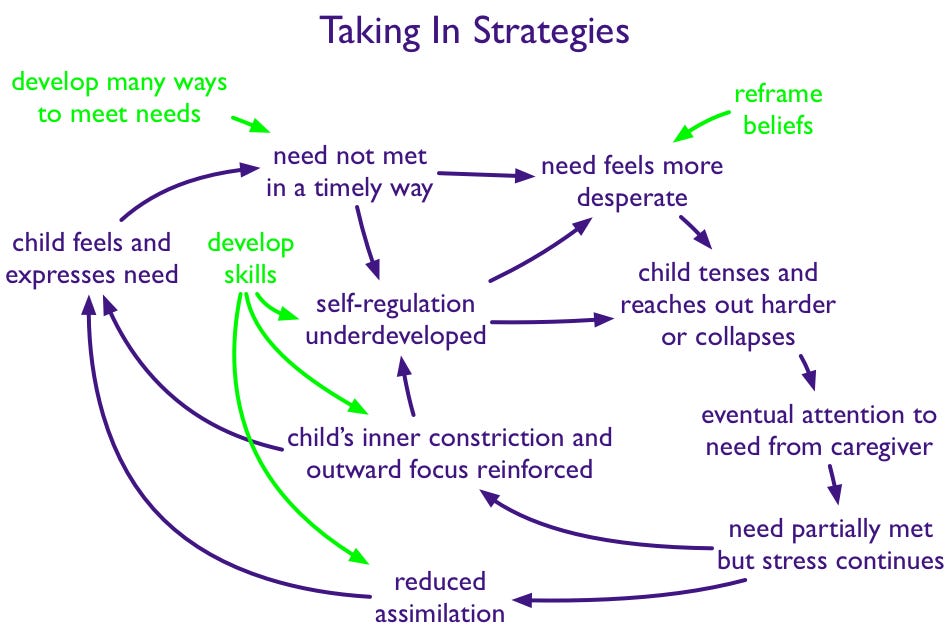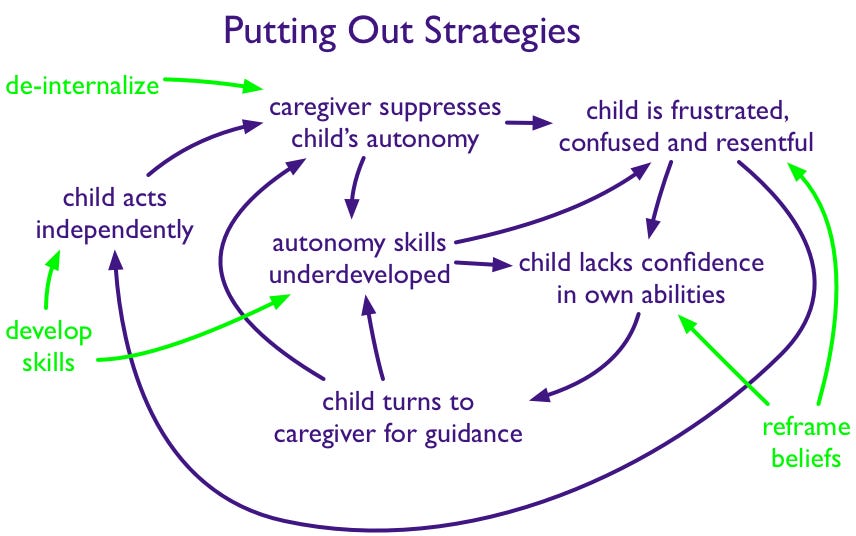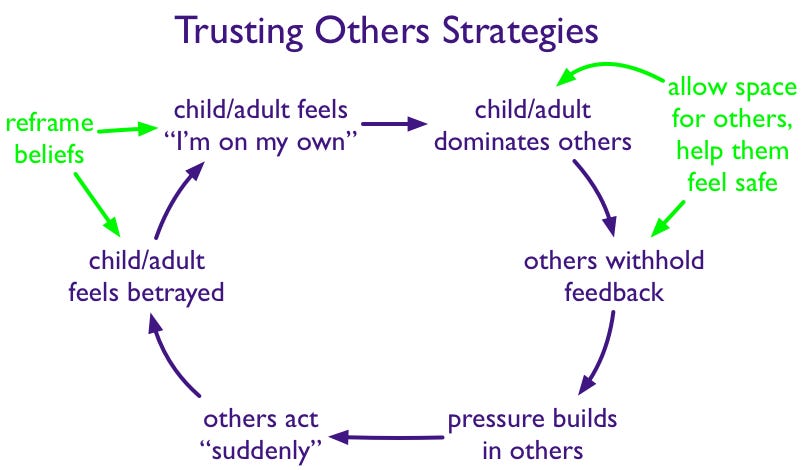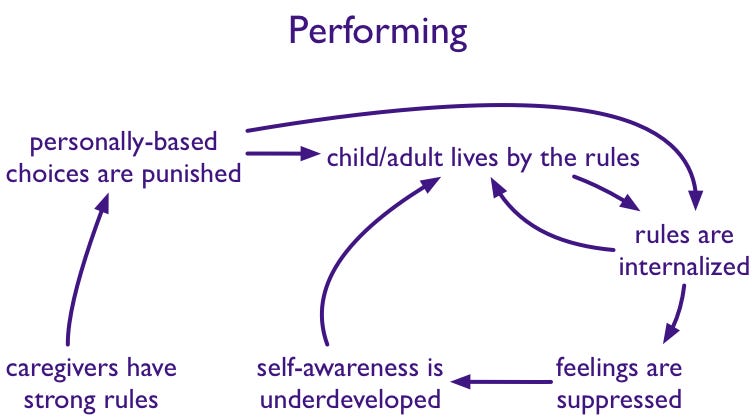[This is part of BFNow Self-Study Module 4: Systems & Habits. For more about the overall Self-Study program, please look at About BFNow Self-Study and BFNow Self-Study Orientation.]
If you haven’t done so already, let me encourage you to pause, relax and release, perhaps with a big stretch or three deep breaths.
Today we blend the work of Modules 3 & 4. The goal is for you to get a clearer sense of what keeps the character styles in place – and then how to intervene to change those styles and complete the developmental tasks.
Each of the character styles persists because it’s supported by self-reinforcing systems. This exploration provides system diagrams for all of the styles and then companion diagrams with intervention strategies. The Experiential will ask you to pick one of the styles to work with.
The imperative statements in each heading are the healing goals for each character style.
1. Embodiment –
“Feel comfortable and safe in your body.”
Here’s a self-reinforcing system that helps keep the Leaving style in place. As with all the defense patterns, Leaving compensates for the incompleteness of its associated development task, in this case Embodiment.
(This diagram is not meant to be THE one true diagram. Rather, it is meant to illustrate a process for which there can be many variations and different descriptions.)
The outer loop, with the caregiver and the infant, is meant to show how the process starts, while the inner loop, with the child/adult, is meant to show how the process continues.
To change this pattern, it helps to intervene in multiple places. The system is robust enough that it will likely adjust and accommodate if you work on only one part.
Two recurring healing strategies, for all of the character styles, are develop skills/habits and reframe beliefs:
You need to develop skills and habits relevant to the development task that you didn’t fully learn as a child.
When you didn’t learn those skills or habits but developed a work-around instead, you took on various beliefs that support the work-around and interfere with completing the development task. These beliefs need to be changed into beliefs that can help you complete the development task.
Developing skills and habits as well as changing beliefs often benefits from various techniques that work directly with the body and the subconscious. The best result seem to come from combining cognitive and non-cognitive processes. (Kessler’s book, The 5 Personality Patterns, has a wealth of specific healing approaches for each character style.)
Another recurring healing strategy, not on these diagrams but in all of the Module 3 Experientials, is for your Optimal Zone adult sub-personality to supportively connect with the wounded child sub-personality associated with each character style. Consider this as a general strategy to be included with the more specific strategies on the diagrams.
OK, so here are a set of healing strategies to complete the Embodiment task:
The specifics of how to reframe beliefs and develop skills will be along the lines described in the Embodiment Exploration (Module 3 - Exploration 1) and will depend on the details of each person’s situation. The diagram just provides general strategies that can serve as a starting point. (“Regulation” is the psychologists’ term for the ability to move yourself back toward your Optimal Zone after you have been triggered.)
It is useful to work on all three interventions in parallel. If you develop the skills of self-regulation, it will be easier to calm your nervous system and likewise to reframe your beliefs around safety. If you are able to reframe your beliefs, it will also be easier to calm your nervous system and develop new skills. If you’re able to calm your nervous system, it will be easier to develop new skills and reframe beliefs. They all reinforce each other.
2. Taking In –
“Feel confidently nourished and supported from a variety of sources, including those within yourself.”
Moving on, here’s a self-reinforcing system that keeps the Pulling style in place:
This diagram focuses on the experience of a child but with a little variation it could apply to adults as well. You can think of the “child” as the wounded child sub-personality that you still carry with you.
Here are points of intervention and healing:
The skills here include self-regulation; an inner relaxation and openness that allows your internal energy to flow; and skills that improve assimilating the “nourishment” (food or otherwise) that comes your way.
The self-reinforcing system for the compensated variant of Pulling looks like this:
I haven’t done a separate intervention diagram for Compensated Pulling because, to get at the underlying issues, it’s the same as the Taking In Strategies diagram above.
3. Putting Out –
“Grow into a confident sense of your own creative, expressive capacity.”
Again, the following diagrams focus on the experience of a child but with a little variation they could apply to adults as well – or to the wounded child sub-personality.
Here are points of intervention and healing:
De-internalize means quieting the internalized voice of the caregiver, which often shows up as the Inner Critic.
4. Trusting Others –
“Settle into a comfortable sense of support and resiliency
via appropriate trust of others and of life.”
Let’s apply the same pattern to the last two character styles:
Here are points of intervention and healing:
5. Trusting Self –
“Discern your own inner direction and know how to follow it.”
Here are points of intervention and healing:
Experiential
Start this in the morning, let ideas come to you throughout the day and then return to it in the evening.
Pick one of the character styles that is strong in you and explore how you might apply the strategies for yourself.
Thanks,
Robert
[Link back to the Module 4: Systems & Habits Overview page.]


